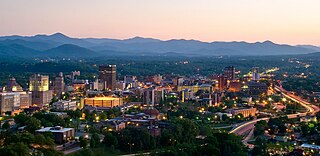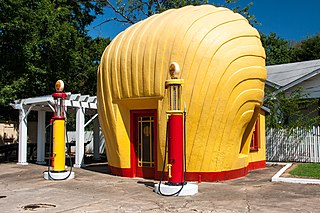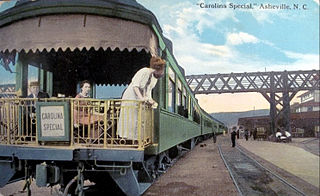
Clifton Forge is a town in Alleghany County, Virginia, United States which is part of the greater Roanoke Region. The population was 3,555 at the 2020 census. The Jackson River flows through the town, which as a result was once known as Jackson's River Station.
Five Points may refer to:

Asheville is a city in and the county seat of Buncombe County, North Carolina, United States. Located at the confluence of the French Broad and Swannanoa rivers, it is the most populous city in Western North Carolina, and the state's 11th-most-populous city. According to the 2020 census, the city's population was 94,589, up from 83,393 in the 2010 census. It is the principal city in the four-county Asheville metropolitan area, which had an estimated population of 417,202 in 2023.

Winston-Salem is a city in and the county seat of Forsyth County, North Carolina, United States. At the 2020 census, the population was 249,545, making it the fifth-most populous city in North Carolina and the 91st-most populous city in the United States. The population of the Winston-Salem metropolitan area was estimated to be 695,630 in 2023. It is the second-most populous city in North Carolina's Piedmont Triad region, home to about 1.7 million residents.

America's 11 Most Endangered Places or America's 11 Most Endangered Historic Places is a list of places in the United States that the National Trust for Historic Preservation considers the most endangered. It aims to inspire Americans to preserve examples of architectural and cultural heritage that could be "relegated to the dustbins of history" without intervention.

North Carolina Highway 150 (NC 150) is a primary state highway in the U.S. state of North Carolina. It serves the Foothills and Piedmont Triad areas of the state, connecting the cities of Shelby, Mooresville, Salisbury and Winston-Salem.

The Shell Service Station in Winston-Salem, North Carolina, is a former filling station constructed in 1930 following a decision in the 1920s by the new local Shell distributor, Quality Oil Company, to bring brand awareness to the market in Winston-Salem. The building is an example of representational or novelty architecture and was listed on the National Register of Historic Places on May 13, 1976. It is located in the Waughtown-Belview Historic District at the corner of Sprague and Peachtree Streets.
West End Historic District, or Westend Historic District, and variations with Commercial or Old or other, may refer to:
WMIT is a non-profit FM radio station licensed to Black Mountain, North Carolina, United States.
Salem Historic District or variations with Downtown or Old may refer to:
There are many different types of transportation in North Carolina, including air, rail, mass transit, and major highways. North Carolina is a rapidly growing state with over 10.4 million people and requires multiple types of transportation. Currently, NC has 10 commercial and many municipal airports, a passenger rail called NC By Train operated by North Carolina in partnership with Amtrak with many different routes, public bus transportation in cities like Raleigh and Charlotte, and highways that span the State.

The Carolina Special was a passenger train operated by the Southern Railway between Cincinnati, Ohio, and the Carolinas. It operated from 1911 to 1968. It was the last passenger train to use the route of the Charleston and Hamburg Railroad, which, as the South Carolina Canal and Railroad Company, began operation in December 1830, as one of the oldest railroads in the United States, and, by 1833, operated a 136-mile (219 km) line to Hamburg, South Carolina, on the Savannah River, the country's longest at that time. All Southern Railway Pullman service to Charleston rode over that historic, if bucolic, route from Branchville to the port city.

West Asheville End of Car Line Historic District is a national historic district located at Asheville, Buncombe County, North Carolina. The district encompasses 24 contributing buildings in a primarily commercial section of West Asheville. It includes a nearly continuous row of one and two-story brick and concrete block commercial buildings that date from 1916 through the mid-1930s. Their development was influenced by streetcar service along the Haywood Road corridor that operated from 1910 to 1934. Notable buildings include the separately listed Bledsoe Building, along with the Isis Theater (1937), Franklin Building (1923), Pure Oil Station (1947), Wells Building (1917), Palace Theater (1928), Great A&P Tea Company (1926), and West Asheville Post Office (1929).

Black Mountain Downtown Historic District is a national historic district located at Black Mountain, Buncombe County, North Carolina. The district encompasses 56 contributing buildings and 1 contributing structure in the central business district of Black Mountain. The district includes a variety of late-19th and early-20th century commercial and institutional buildings in the Commercial Style, American Craftsman, Classical Revival, Art Deco and Art Moderne. Notable buildings include the George Stepp House (1907), Black Mountain Depot (1909), firehouse (1921) designed by Richard Sharp Smith, town hall (1927), Kaltman Building (1928), and Pure Oil Service Station.

Downtown North Historic District, also known as Trade Street District, is a national historic district located at Winston-Salem, Forsyth County, North Carolina, USA. The district encompasses 46 contributing buildings in a commercial section of Winston-Salem. They were built between about 1907 and 1952, and most are one- or two-story brick buildings, sometimes with a stuccoed surface. Notable buildings include the Beaux-Arts style former United States Post Office with an addition by Northup and O'Brien, Brown-Rogers-Dixson Company Building (1928), Centenary Church Education Building (1920s), Pure Oil Station, City Market (1925), and Twin City Motor Company (1925).

NC By Train is a brand name used by the Rail Division of the North Carolina Department of Transportation (NCDOT) for two state-supported Amtrak routes operating in the U.S. state of North Carolina–the Carolinian and the Piedmont.










